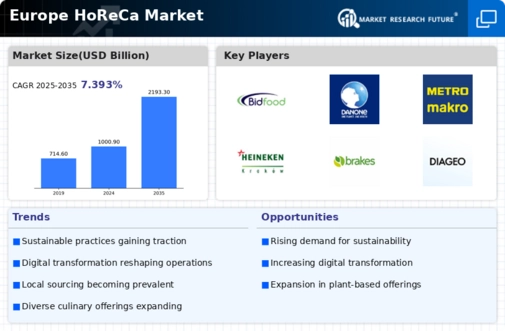The Europe HoReCa market, encompassing the hotel, restaurant, and catering sectors, presents a dynamic and competitive landscape characterized by an evolving consumer palate, increasing emphasis on sustainability, and the integration of technology in service delivery. As operators strive to meet the diverse demands of their clientele while maintaining profitability, competition among suppliers, distributors, and service providers intensifies. Market participants must continually adapt to rapid changes, including shifts towards healthier and locally sourced food options, as well as the growing trend of digitalization that enhances customer experience and operational efficiency.
The strategic positioning of key players within this sector significantly influences market trends, pricing strategies, and customer loyalty, ensuring that stakeholders remain vigilant in anticipating the needs of both operators and consumers.Bidfood has established a strong foothold in the Europe HoReCa market, leveraging its extensive distribution network and product range to cater to diverse culinary needs across the region. The company's strengths lie in its ability to provide a comprehensive portfolio of food, beverage, and non-food products tailored specifically for the hospitality sector, ensuring operators can source everything they require from a single supplier.
Bidfood's commitment to quality and customer service fosters trust and long-term relationships with clients, allowing it to maintain a competitive edge.
Additionally, the company enhances its value proposition through tailored solutions that meet the specific requirements of various establishments, from upscale restaurants to casual dining venues, further solidifying its market presence.Danone operates as a key player in the Europe HoReCa market with a focus on providing dairy products, plant-based alternatives, and water solutions that align with evolving consumer preferences. The company’s diverse product portfolio includes a wide array of yogurts, cheeses, and beverages, which are increasingly favored for their health benefits and premium quality.
Danone's market presence is enhanced by its partnerships with distributors, which ensure consistent availability of its key products across the hospitality landscape.
The company capitalizes on its strengths, particularly its commitment to sustainability and innovation, which resonate well with environmentally conscious consumers and operators. Through strategic mergers and acquisitions, Danone has further strengthened its market position, allowing it to expand its reach and enhance its product offerings tailored to the unique needs of the European HoReCa segment, thereby reinforcing its reputation as a trusted supplier in this competitive market.























Leave a Comment